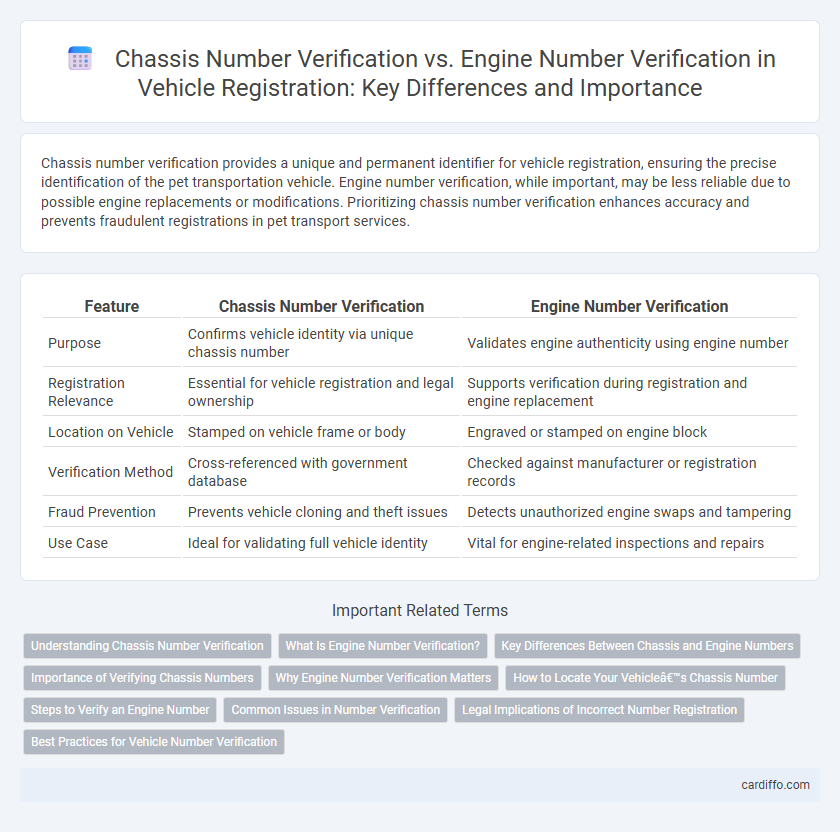Chassis number verification provides a unique and permanent identifier for vehicle registration, ensuring the precise identification of the pet transportation vehicle. Engine number verification, while important, may be less reliable due to possible engine replacements or modifications. Prioritizing chassis number verification enhances accuracy and prevents fraudulent registrations in pet transport services.
Table of Comparison
| Feature | Chassis Number Verification | Engine Number Verification |
|---|---|---|
| Purpose | Confirms vehicle identity via unique chassis number | Validates engine authenticity using engine number |
| Registration Relevance | Essential for vehicle registration and legal ownership | Supports verification during registration and engine replacement |
| Location on Vehicle | Stamped on vehicle frame or body | Engraved or stamped on engine block |
| Verification Method | Cross-referenced with government database | Checked against manufacturer or registration records |
| Fraud Prevention | Prevents vehicle cloning and theft issues | Detects unauthorized engine swaps and tampering |
| Use Case | Ideal for validating full vehicle identity | Vital for engine-related inspections and repairs |
Understanding Chassis Number Verification
Chassis number verification is a crucial step in vehicle registration that ensures the authenticity and legal ownership of the vehicle by matching the unique vehicle identification number (VIN) stamped on the chassis with official records. This process helps detect stolen vehicles, prevent fraud, and verify compliance with regulatory standards. Unlike engine number verification, chassis number verification targets the primary structural frame of the vehicle, providing a more comprehensive validation of the vehicle's identity.
What Is Engine Number Verification?
Engine number verification is a crucial process in vehicle registration that confirms the authenticity and legality of a vehicle's engine by matching its unique identification number with official records. This verification helps to prevent fraud, theft, and ensures the engine corresponds to the vehicle chassis and registration documents. Accurate engine number verification is essential for validating vehicle ownership and compliance with regulatory standards.
Key Differences Between Chassis and Engine Numbers
Chassis number verification involves validating the vehicle identification number (VIN), a unique code assigned to the vehicle's frame to ensure its authenticity and traceability. Engine number verification focuses on the specific alphanumeric code engraved on the engine block, which identifies the engine unit separately from the vehicle body. The key difference lies in their scope: the chassis number tracks the entire vehicle's identity, while the engine number confirms the engine's originality and matching status with the chassis for registration and legal purposes.
Importance of Verifying Chassis Numbers
Verifying the chassis number is crucial for accurate vehicle registration as it serves as a unique identifier linked to the vehicle's official records and ownership history. Unlike engine numbers, which can be altered or replaced during repairs, chassis numbers are permanently stamped on the frame, making them more reliable for confirming authenticity and preventing fraud. Ensuring the chassis number matches registration documents helps avoid legal issues and protects against vehicle theft or illegal resale.
Why Engine Number Verification Matters
Engine Number Verification plays a crucial role in vehicle registration because it ensures the authenticity and legality of the engine, preventing fraud and stolen engine usage. Unlike Chassis Number Verification, which confirms the vehicle's frame identity, Engine Number Verification validates the power unit, which can be replaced or tampered with independently. Accurate Engine Number Verification protects buyers from illegal modifications and helps maintain vehicle compliance with regulatory standards.
How to Locate Your Vehicle’s Chassis Number
The chassis number, also known as the Vehicle Identification Number (VIN), is typically located on the driver's side dashboard visible through the windshield, or inscribed on the vehicle's frame near the engine bay or door pillar. This unique alphanumeric code is essential for chassis number verification during vehicle registration, ensuring the authenticity and legal identity of the vehicle. Locating the chassis number accurately differs from engine number verification, which involves checking the engine block and serves to confirm engine originality rather than the entire vehicle's identity.
Steps to Verify an Engine Number
To verify an engine number, start by locating the number stamped on the engine block, usually found near the base or side of the engine. Cross-check the engine number with the vehicle registration documents and manufacturer's records to ensure consistency and authenticity. Finally, consult the authorized service center or use online databases to confirm that the engine number matches official records and has not been tampered with.
Common Issues in Number Verification
Chassis Number Verification often encounters issues such as mismatched or tampered numbers due to fraudulent activities, leading to registration delays and legal complications. Engine Number Verification frequently faces problems like corrosion or wear that makes the number illegible, complicating the authentication process. Both verification processes require meticulous inspection to ensure the numbers align with official vehicle documents for seamless registration.
Legal Implications of Incorrect Number Registration
Incorrect registration of chassis or engine numbers can lead to serious legal consequences, including vehicle seizure, fines, and criminal charges related to fraud or theft. Chassis number verification is critical for establishing vehicle identity, as it is a unique, stamped identifier, while engine number verification ensures the engine matches the registered vehicle's specifications. Failure to accurately verify and register these numbers compromises legal ownership and may complicate insurance claims, resale, and transfer processes.
Best Practices for Vehicle Number Verification
Chassis Number Verification provides a permanent, tamper-resistant identifier essential for accurate vehicle registration, while Engine Number Verification offers supplemental confirmation but is subject to changes and replacements. Best practices for vehicle number verification emphasize prioritizing chassis number checks through authorized databases to ensure authenticity and prevent fraud. Combining both verifications enhances thoroughness, but reliance on chassis number data remains the most reliable approach for legal and administrative processes.
Chassis Number Verification vs Engine Number Verification Infographic

 cardiffo.com
cardiffo.com